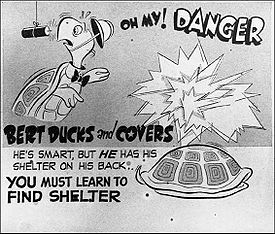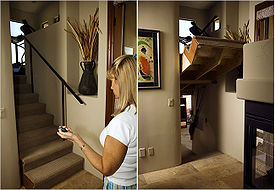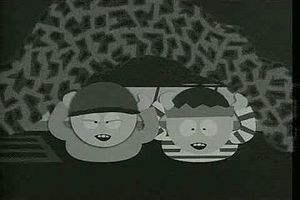Hibernation Tactics
| Survivor Tactics |
| The information on this page or section discusses a survivor strategy. |
| ||||
Introduction
Hibernation Tactics are a broad range of strategies which seek to gain an advantage over zombie horde and mega-horde incursions through avoidance. Borrowing heavily from concepts cultivated in Ninjutsu, practitioners of Hibernation Tactics do not directly conflict with the thrust of enemy strikes, instead exploiting the built-in inactivity mechanics & the revivification process to survivor advantage.
Conceptually, Hibernation Tactics are simply any plan that uses extreme methods of avoidance of the enemy as a positive characteristic. There are similarities to River Tactics and DIRT:NAP, as it is the extreme edge of avoidance tactics, as practitioners of Hibernation Tactics do not typically engage zombie hordes in any form. It is the direct opposition to Dam Tactics and meat-shield tactics (see below).
These tactics, employed in an organized and efficient manner, create a powerful survival tool.
There was a turtle by the name of Bert
and Bert the turtle was very alert;
when danger threatened him he never got hurt
he knew just what to do...
He'd duck! [gasp]
And cover!
Duck! [gasp]
And cover! (male) He did what we all must learn to do
(male) You (female) And you (male) And you (deeper male) And you!'
[bang, gasp] Duck, and cover!'
- Duck and Cover civil defense film, 1951
Analysis of Defense
He who knows when he can fight and when he cannot will be victorious. - Sun Tzu
Zombie hordes move in concentration to their specified targets. In small scale hordes, they may focus on specific buildings or complexes such as Malls. Larger hordes and mega-hordes migrate from suburb to suburb, corroding everything in their path, laying waste to the entire area. They move in large masses, a rolling wave of destruction that consumes everything.
There are many tactics employed by survivors to effectively hold off a zombie assault (See How To Win A Mall Siege for defensive techniques, and when they are more appropriate than Hibernation Tactics). The effectiveness of these tactics relies on how long a survivor can sit in a building before the horde destroys it. If the AP used to erect defenses is insufficient to counter the level of AP being used to destroy them (bearing in mind that building barricades is inherently easier than destroying them), breaches occur. Once breaches occur, then some AP is needed to eliminate any invading zombies as well as sealing the breach. Should zombies successfully make a breach and ransack a building, all zombies inside the building must be killed, and the building repaired, before the barricades can be erected again.
While Hibernation Tactics advocates playing dead, or hiding in plain sight, it has been proven that coordinated and dedicated survivor efforts can withstand the onslaught of a horde. This strategy of avoiding the zombie threat is sound on a number of levels, but in some circumstances a redeployment is counter productive; group leaders must gauge their own circumstances. Survivors do not need to flee from every pack of zombies, but it is important to note that whenever a defensive situation arises where survivors are spending actions to barricade and zombies are spending actions to tear down barricades the AP on both sides cancel each other out (unequally).
Directly opposing zombie concentrations is a dangerous proposition, and requires an investment of AP on behalf of the survivor population. Without superior numbers and vigilance, it is foolish to weather a siege. As such, practitioners of Hibernation Tactics do not actually defend a suburb or location. They are constant re-builders, much like children making sand castles at low tide. Constant waves of zombie hordes wash over what they have built, but practitioners of Hibernation Tactics step out of the action instead of trying to protect what they have made, only to scrabble back to start anew once the danger has passed.
Zombies don’t Can Hold Territory
Much like River Tactics, Hibernation Tactics also capitalizes on a phenomenon of zombie ‘society’ – congregation. Zombies form packs and hordes and use their numbers to crack safehouses and feast on their inhabitants. Ironically, this is an advantage for survivors. The larger the horde, the smaller the affected areas and the more traceable and predictable the threat.
However, what do you do when everything is being wrecked, and zombie hordes are spreading out to cover entire suburbs?
March of the Dead
The first March of the Dead drove survivor numbers to record lows, causing many survivors find that one cannot hold a position against a determined opponent who has the advantage of superior numbers and superior coordination. With much of Malton contested or ruined, it was difficult to utilize River Tactics to its full extent, as zombies started targeting the designated free running lanes (buildings that survivors used to freely get around in suburbs) as well as valuable resource buildings. With such widespread devastation, survivors had to consider alternative tactics.
Employers of Hibernation Tactics understand that a building is going to be breached, if a zombie horde really wants to get in, they are going to get in. They know that multiple suburbs can be wrecked, with streets frequently patrolled, and ruins held or turned into Pinatas. In this event, employers of Hibernation Tactics are determined to "wait out" a zombie siege of an area by simply not playing a particular character until the zombie players have gotten bored and moved on.
Invisibility
O divine art of subtlety and secrecy! Through you we learn to be invisible, through you inaudible and hence we can hold the enemy's fate in our hands. - Sun Tzu
Employers of Hibernation Tactics capitalize on the Inactivity mechanic that is inherently built into Urban Dead to completely avoid the destructive force of the zombie siege, and to wait out occupation of the area. By not logging into their character, the Inactivity mechanic removes the player from the list of players in a particular location and makes the character impossible to interact with, or even to be seen in the room, hence becoming "invisible".
Prior to its widespread use, this sort of tactic was usually employed on accident, where a player who played the game infrequently would log into an inactive character and find the suburb that they were in was ruined. It wasn't until some players found an advantage in using the Inactivity mechanic, that its use started to become a recognized tactic.
Seeding
Over time, some players and/or groups would purposefully idle out in a suburb that was slated to be the next zombie horde target (as many zombie groups would publicly announce their targets, such as the Big Bash or the Mall Tour for example). This deliberate use of the Inactivity mechanic in order to avoid hordes and quickly repair a suburb is called "seeding".
Traditionally, a character who is going to be seeded in a suburb is loaded down with everything needed to bring needed Resource Buildings back up to active status and revive survivors who are languishing in formerly active Revive Points. Typically, the survivors who are seeded are equipped with: Fuel Cans, Portable Generators, a Toolbox, Revivification Syringes, and some form of offensive weaponry (depending on the preference of the player). The player can choose where to leave their survivor to go Inactive in order to maximize their AP when they come out of Inactivity. The turnaround time for repairing suburbs is increased, as the moment a horde leaves an area, the repair work begins.
Players will know that their character will have maximum Action Points when they log in, as the Inactivity mechanic takes five days to kick in and render a character invisible.
Waiting
It takes five days for the Inactivity mechanic to kick in, which leaves the survivor to play a waiting game to see if they are successful at becoming invisible or not. Anything can happen to the character during that time, and while normally a player can log in to monitor their surroundings without spending any AP, a player trying to utilize the Inactivity mechanic, cannot. Logging into an Inactive character brings a character out of hiding and back into active status, thus allowing the character to be subjected to attacks from survivors and zombies alike. As such, practitioners of Hibernation Tactics have monitor their character's status via alternate means prior to the Inactivity mechanic kicking in.
One way to do this, is by viewing the character's Profile link while not logged in. If the fields Died and First Died are present in the survivor's profile, then the character has suffered a death, and would need to be revived in order to successfully attempt this form of Hibernation Tactics again. If a character dies, then the player would have to log in, have the character revived, and then re-place the survivor in the chosen location, in order to start the wait for Inactivity again.
Once the Inactivity mechanic has kicked in, a player can be certain of their survivor's safety. During this time the player might play one or more other characters, in order to fill the gap that is created while they are waiting for their character to become Inactive.
Communication
Unlike in most forms of survivor tactics, many employers of this form of Hibernation Tactics, typically do not monitor in-game communication of any kind. Logging into an Inactive character brings a character out of hiding and back into active status, thus allowing the character to be subjected to attacks from survivors and zombies alike. Some practitioners monitor the status of the suburb on its respective wiki page, utilizing the scouting of other players to let them know when it is safe enough to pop back into the game. Some players have their other characters keep Portable Radios tuned into the Radio Frequencies for the area that their Inactive character is seeded in, in order to determine when it is safe to log back into the character.
Other players monitor zombie chatter on various forums and chat channels (traditionally a community-reviled tactic called Forum Spying), in order to see when a particular horde had moved on.
"Duck & Cover"
Stigma
A social stigma exists over the Roleplaying element of Hibernation Tactics. Some players feel that by exploiting the Inactivity mechanic or lurking as a revivifying body, practitioners of Hibernation Tactics are breaking the "immersive" experience of the game for other players, as they feel that these actions are not something a character could feasibly do in a real world sense.
Critics of Hibernation Tactics argue that the use of the Inactivity mechanic or lurking as a revivifying body is simply not playing the game, and is not a viable tactic. Further, that employers of Hibernation Tactics are avoiding half of the concept of the game in favor of always being alive.
Employment of Hibernation Tactics around Malton
If you look at the Survivor-Zombie Imbalance, there has been several times when these forms of tactics were used on the large scale by multiple groups; typically when survivor numbers dramatically decrease.
- March of the Dead - In 2008, a group of players from the Something Awful (SA) forums formed a zombie group called The Dead, who had the aim of killing each and every last survivor in Malton.
- Monroeville - In 2008, a second city had come out, where players only had one life (as there were no revivification syringes to bring them back to life), and staying alive proved to be very difficult. This tactic was extremely common for survivors and zombies alike until Kevan disabled inactivity in that city.
- March of The Dead 2 - In 2011, a group of players from the Something Awful (SA) forums reformed their zombie group, and were nicknamed The Dead 2.0, who had the aim of killing each and every last survivor in Malton.
Optional Wiki Page Tag
Feel free to add this anywhere on your personal or group page to show your support!
| Supporter of Hibernation Tactics | |
| I become the void. |
Simply paste the code below anywhere on your Wiki page:
{{SHibernationTactics}}
-or-
 |
Hibernation Tactics Supporter |
| This User or Group supports Hibernation Tactics. |
Simply paste the code below anywhere on your Wiki page:
{{Hibernation Tactics}}




